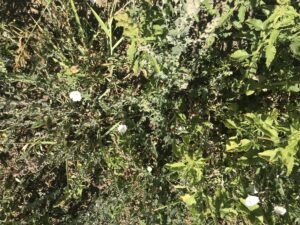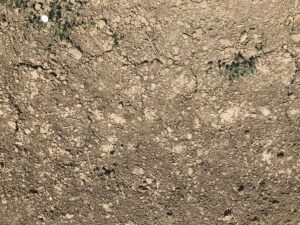Soil Solarization and Biosolarization
By Martin Guerena, NCAT Agriculture Specialist
Solarization
Imagine harnessing the sun’s energy to destroy your enemies. Like Archimedes—the ancient Greek who used mirrors to concentrate sunlight to burn the Roman fleet—farmers can utilize the sun to destroy or disable insects, diseases, nematodes, and weeds in the field. The technique known as solarization consists of laying clear, plastic mulch on moist soil. Solarization during the hottest months of year, which in some areas can begin in mid-spring and last through early fall, can raise soil temperatures to levels that kill or debilitate many soil pathogens, insects, nematodes, weed seeds, and seedlings. The effect of solarization may last many years, depending on how thorough the solarization was and how heavily the soil is tilled in following years. Solarization improves soil tilth and releases many nutrients—primarily nitrogen in the form of ammonium and nitrates, as well as calcium, magnesium, and potassium—to the crop.
Steps in solarization:
- Prepare the area by disking or tilling the soil. Break down the clods and make the surface as smooth as possible.
- Water the soil deeply to about 70% of water-holding capacity.
- As soon as you can reenter the field, cover the area with clear, UV-resistant plastic.
- Plastic can be laid flat over large areas or in strips over beds.

Flat solarization. Photo: Martin Guerena, NCAT
- Strip solarization on beds leaves the furrows out of the heating process; therefore, weeds will emerge once they get wet. Drip tape may be placed in the center of the bed before the plastic is applied for irrigation, once the solarization process is complete and the crop is planted. With strip coverage, however, long-term control of soil pathogens and nematodes may be lost because pests in the untreated soil in the rows between the strips can contaminate and reinfest treated areas.
- Flat solarization may have shallow beds or no beds. Forming beds after flat solarization may bring up weed seeds, depending on how deep the bed shaper goes. Flat solarization is recommended if the soil is heavily infested with soilborne pests or perennial weeds because there is less chance of reinfestation by soil being moved to the plants through cultivation or furrow irrigation water.
- Bury the plastic edges in the soil to trap and retain the heat.
- Leave the plastic in place for four to six weeks, depending on location, for deep, full solarization effect. Soil texture may determine time needed for maximum benefit: clay holds more water and heat than sandy soils do, for example.
Once solarization is occurring, make sure to repair any tears in the plastic with patching tape. If the wind lifts the plastic’s edge, quickly rebury the edges to keep the heat and moisture in.
Drawbacks of solarization include the following:
- Keeping land out of production while solarization occurs.
- Removing and disposing of the plastic mulch. Until a strong, durable, biodegradable plastic is developed, farmers will have to rely on petrochemically produced polyurethane, which ends up in the landfill. Plastic used in flat solarization can be cut and folded into manageable pieces for reuse.
- Areas with high winds, too much rain, or fog may hinder solarization.
- Perennial weeds like nutsedge, field bindweed, Bermuda grass, or Johnsongrass are more difficult to control, especially in bed-strip solarization or on the edges of flat solarization.
- Beneficial microorganisms will also succumb to the high temperatures, but they do recover and eventually re-establish themselves.
- May have to inoculate with rhizobium if planting a legume.

How hot does the soil get during solarization?
It depends on the soil texture and the amount of moisture the soil is holding. The sandier the soil, the less water it holds and therefore the less heat that is transferred. Clay soils hold more water than sand and transfer heat throughout the profile more readily. The photos above show a simple 6-inch cooking thermometer used to monitor soil temperatures at the surface right under the plastic, at three inches deep, and at six inches deep. The location is in Davis, California, about 4 p.m. on July 16, 2015, with an ambient temperature of 93°F. Photo 1 shows the thermometer at 129°F on the soil surface right under the plastic sheet. At these temperatures for four weeks, all seeds and seedlings on the surface essentially cook and are non-viable. In photo 2, the thermometer reads 110°F at three inches below the surface, and in photo 3, the thermometer reads 100°F at six inches below the surface. The weed seed bank in this profile is exposed to these high temperatures for longer periods than normal, affecting seeds’ viability and germination rate (Vidotto et al., 2013).
Biosolarization
Biosolarization combines solarization with anaerobic soil disinfestation (ASD). ASD creates temporary anaerobic conditions in the soil that encourage anaerobic microorganisms that break down available carbon sources, producing organic acids, aldehydes, alcohols, ammonia, metal ions, and volatile organic compounds that are toxic or suppressive to soil pests and diseases (Momma, 2008; Huang et al., 2015; van Agtmaal et al., 2015; Achmon et al., 2017). The addition of organic amendments provides the carbon source responsible for this bio-pesticidal process. The amendments or biomass can be composted materials or non-composted biomass (i.e., cover crops or crop residue). Processed or composted biomass has lower available carbon; it introduces more beneficial organisms and is usually recommended as a co-amendment. Non-processed biomass, such as disked-under cover crop or agricultural byproducts like pomace or manure, induces conditions in soil that support fermentation and results in accumulation of volatile fatty acids (VFAs), making it more effective in biosolarization. Five tons per acre of biomass application is recommended. The time needed for biosolarization is five to nine days in order to accumulate VFAs to inactivate weed seeds and soilborne plant diseases (Achmon et al., 2017; Momma, 2008). If agricultural waste is used, the finer the particles, the quicker the microorganisms can consume it. Incorporating the biomass deeply into the soil results in better fumigation effect deep in the soil’s profile. Once biosolarization is complete, the soil may need to re-aerate for at least a week after plastic removal before planting.
Advantages of biosolarization over regular solarization include the following:
- Recycles farm waste.
- Shorter application period (five to nine days).
- Effective in cooler areas with less sunshine.
- Can begin process immediately after disking under a cover crop.
- Improves soil quality with added biomass.
- Effective in deeper soil layers.
The risks and costs of conventional fumigation to human safety and environmental health make solarization and biosolarization safe, effective, and sustainable alternatives to control of a wide range of pests in many parts of the country.

Control with nutsedge, malva, lambsquarter, field bindweed, pigweed, and crabgrass. Photo: Martin Guerena, NCAT
Solarization and Biosolarization Trials
Two trials were performed on six farms in Northern California. The first trial was conducted in late summer/early fall between August 13 and October 13, 2020. The second trial was conducted in late spring/early summer from April 28 to July 9, 2021. Each of the nine treatment plots was approximately 5’ x 9.67’, totaling 0.01 acres. The statistical test known as analysis of variance (ANOVA) was used to analyze the data drawn from results of the treatment’s weed stands measured by canopy percentage on these plots. Weed germination was evaluated by comparing the control plot’s canopy to the other treatment areas using Canopeo, a green canopy cover measurement tool. Each farm had nine test plots with three separate treatments randomly assigned: three plots for control with no treatment; three plots for solarization with clear plastic cover for 32 days; three plots for biosolarization with 5 tons/acre equivalent of compost and covered with clear plastic for eight to 10 days. The research plots on each farm were laid out in a randomized complete block design.

Solarization for four weeks with field bindweed. Photo: Martin Guerena, NCAT
The results of both trials indicated that solarization and biosolarization treatments had a significant effect on weed germination or percentage vegetation cover. There was no significant difference in percentage vegetation cover observed between solarized and biosolarized plots; however, the reductions in percentage vegetation cover achieved by biosolarization occurred in roughly a quarter of the time that it took for solarization to achieve. Additional studies are needed to determine under which environments solarization and biosolarization are viable weed control practices, but our study suggests that biosolarization is indeed an effective and quick way to significantly control weeds.
Soil Solarization and Biosolarization
By Martin Guerena, NCAT Agriculture Specialist
Published September 2019
Updated May 2022
IP590
This publication is produced by the National Center for Appropriate Technology through the ATTRA Sustainable Agriculture program, under a cooperative agreement with USDA Rural Development. This publication was also made possible in part by funding from the USDA National Institute of Food and Agriculture, award number 2019-38640-29880 through the Western Sustainable Agriculture Research and Education program, project number OW20-360. ATTRA.NCAT.ORG


